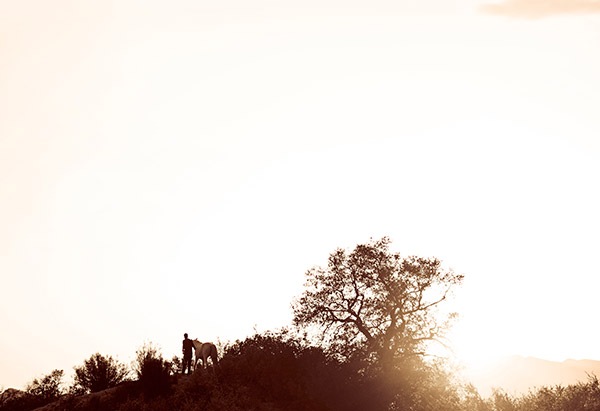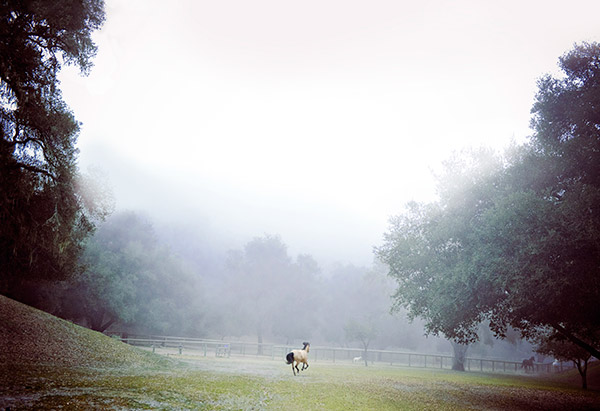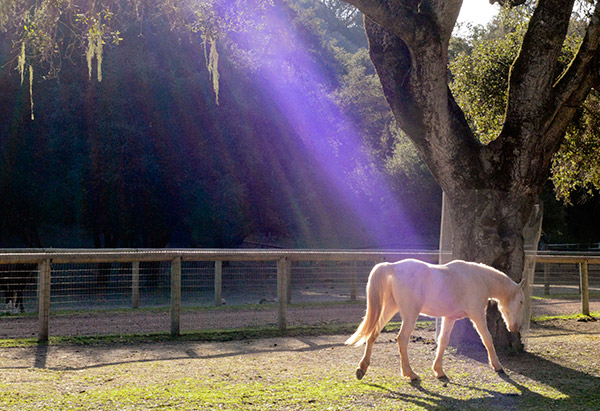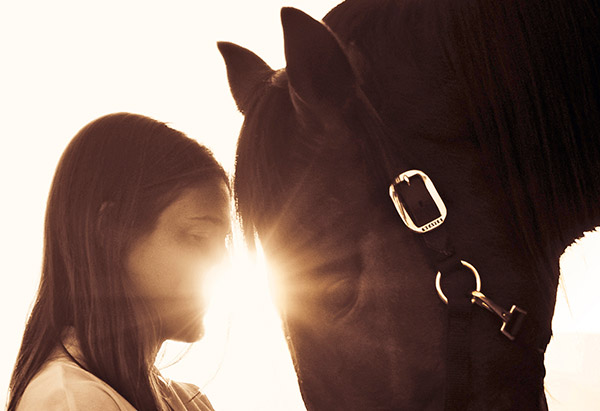
Photo: Phyllis Lane
On a quiet California ranch, Koelle Simpson helps people confront their greatest fears and heal their deepest wounds—by asking them to enter a pen, hold very still, and allow a half-ton creature to guide them toward peace. Martha Beck reports.
A cool coastal-California breeze settles in around us as Koelle Simpson and I, sitting side by side on an observation deck, gaze into a round pen below. Inside the pen, a woman named Avery* stands nervously beside a half-ton chocolate-colored horse named Ernie. She eyes him warily. Ernie eyes her back. Then Koelle gives Avery the deceptively casual, heavily loaded instruction, "Do whatever you want."
Avery looks utterly bewildered. Since her confusion is vital to the process, I just smile.
I've brought Avery to my ranch today to help her understand why she feels anxious and uncertain in her life; why she rages at colleagues, her children, her husband. Though I've been serving as Avery's life coach for several weeks, there are things she can learn here, with Koelle and Ernie, that all the talking in the world could never convey.
But Koelle's request has thrown her. "Do whatever I want?" she repeats. It's clear she has no idea what that might be. Since infancy, Avery—like most of us—has done what she's supposed to do, not what she wants to do. She knows how she's "supposed" to act as a wife, mother, employee. But in equine life coaching, there is no "supposed to." There is you, an animal, and the present moment. What you do with the situation is your choice, and for Avery, choice is an unfamiliar prospect.
An equine coaching session consists of the following: You stand near a horse. You gesture to that horse. It gestures back. For a while, it all feels strange and random. But eventually, in a process beyond verbal description, you begin to feel a cell-deep, almost telepathic communication between you and this creature. Awakening your ability to connect with the horse allows you to understand yourself in entirely new ways. And in the weeks that follow, that understanding quietly transforms your life.
But Avery isn't there yet. For now she just stares at Ernie, paralyzed. He wanders around keeping his distance, smelling the dirt.
Then, without warning, Avery begins to cry. "I feel like I'm supposed to do something," she says, "but I don't know what it is."
"And where else in your life do you feel that way?" asks Koelle.
Avery's voice cracks as she answers, "Everywhere."
"Yes," Koelle says. "The way we do anything is the way we do everything. How you react to the horse is how you react to the rest of your life. That's why we're here."
*With the exception of Koelle Simpson's, all names have been changed.
Next: How interacting with horses can help us tap into our deepest emotions

Photo: Phyllis Lane
An equine coaching session consists of the following: You stand near a horse. You gesture to that horse. It gestures back. And you begin to feel an almost telepathic communication between you and this creature.
Koelle Simpson's life began in Hendersonville, Tennessee, where she was born to an entrepreneurial father and a mother who loved nature, animals and her children in almost equal measure. As a girl, Koelle spent hours with the horses that lived near her rural home. They were reliable, dependable, utterly incapable of deceit or unkindness—something that could not be said of all the humans in her life. Like too many children, she was preyed upon, experiencing sexual abuse that left her feeling broken. She coped by turning to horses, who have been systematically "broken" by humans for thousands of years.
At age 17, Koelle left home on a quest to learn everything she could about horses—from books, from trainers and handlers and most of all, from the animals themselves. Over time, and through thousands of interactions, she learned a skill many call horse whispering, though Koelle downplays the term's mystique. "I'm just communicating with horses in their own language," she says. "It turns out they have a lot to say that humans can really use."
I met Koelle, now 33, nine years ago. At half the age of many master horse trainers, she could already heal animals that seemed damaged beyond repair. I watched Koelle transform a horribly abused horse from a raging, kicking ball of fear to a relaxed companion that followed her everywhere. It took her only a few hours, using no whips, chains, ropes, or violence of any kind. My son Adam, who has Down syndrome, took a ride on a gentle mustang named Navajo that Koelle had rescued from euthanasia. Koelle never broke Navajo. She simply conversed with him until they understood each other.
I've since seen that Koelle can change people, too, helping them heal from abuse, anxiety, compulsions, addictions and negative patterns in careers and relationships. This may be because horses relate to humans in a uniquely fascinating way. They aren't so untamable that they can't form intimate bonds with us, but they can never be fully tamed (like, say, dogs). To connect with them, we must return to our own untamed selves. Over centuries upon centuries, each of our species has influenced the growth of the other, establishing a kinship that is practical, emotional, and more than slightly magical.
Another thing about horses: They're skittish as hell. Imagine living in the open, day and night, knowing that any predator could attack you from any angle at any moment. Because horses evolved in this scenario, they're incredibly sensitive to their environment. Their fears are many, their sense of security easily rattled.
But a horse's panicky instincts are balanced by an equally intense desire for companionship. Since a lone animal is like a walking buffet, horses desperately need one another for protection and constantly exchange social cues, giving affection, setting boundaries. Anxiety, rage, and other unsettled emotions feel dangerous to them, and they'll do whatever they can to escape such frightening energy. If that means edging away, they'll edge. If it means running, they'll run. If it means rearing, kicking, or biting, that's what they'll do. But no horse ever sets out to be violent. They lash out as a last resort—much like we do when we feel tied up and cornered by social obligation, financial pressure, the endless demands of our daily lives.
In other words, horses are very much like humans—especially women, who are less predatory, and more preyed upon, than men. Maybe this is why many girls (I was one of them) are obsessed with horses even if they've never so much as touched one. (Some Freudian analysts believe the girlish obsession with horses is sexual, interpreting the hip action of riding as a form of subconscious masturbation. To these theorists I would say, first, you have obviously never ridden a horse; and, second, for Pete's sake, there are easier ways.)
But I digress. My point is that the similarities between equine psychology and human psychology mean that interacting with horses can tap into some of our deepest emotions. Throughout history, horses have been whipped, hobbled, dragged, and otherwise tortured until they go numb to their instincts and agree to do whatever humans want. This may sound familiar. How many times have you felt the lash of disapproval, the hobbling of your heart's desires, the torture of others' expectations?
Humans who can "speak" in the gestural language horses use to communicate with one another have demonstrated that these animals are amazingly cooperative. They've also found that horses always tell you exactly what they think—and here's where things get interesting, because what horses think of you happens to be what most people think of you, too. The difference: Horses won't lie about it. Flattery, backstabbing, and hidden agendas are unknown to horses. They communicate what they feel, straight up, all the time. Which means that to gain their trust, humans must be genuine, clear, and honest. Which is why horse whispering is such a powerful psychological intervention.
Next: How an equine life coaching session starts

Photo: Phyllis Lane
Simpson with equine life coaches Rider (left) and Grace in San Luis Obispo, California.
From the outside, Avery's life looks perfect: A social-media director at an apparel company, she's married to her college sweetheart, Tyler, and has two spirited teenage children. But there are cracks in the foundation. Tyler drinks too much, and the couple have been arguing a lot. Avery fears she's losing control of her teenagers. She often hears herself exploding at them the way her own mother used to shout at her. Recently, her anger has been leaking out at the office, too. She contacted me after a scathing argument with a Web site developer—over a choice of font—led to a teapot tempest that almost got her fired.
Now, though, in the round pen, Avery is the opposite of fiery, standing in uncomfortable silence as Ernie lurks nearby.
"Tell me," Koelle asks Avery. "How often do you ask yourself what you actually want? Where you'd like to go, what projects sound fun, what would feel delicious to your body and your heart?"
Avery squints as if Koelle were speaking Klingon. "Is that even possible?"
"It's possible right here, right now," Koelle says. "This is the situation: You're in a round pen with a horse. Given that, what do you want to do?"
"Well," says Avery, staring at Ernie. "What does he want to do?"
"Exactly what he's doing," says Koelle. "Within the limits of the situation, horses will always do what they want."
Ernie is an average-size horse, which is to say about ten times as heavy as Avery. He could accidentally crush her foot with a casual step. One solid kick (which Ernie has no intention of delivering) could cave in her skull. And so when he whinnies, trying to call his herd—a sound as loud as a car alarm—Avery tenses and darts a fearful glance at him. Abruptly, Ernie moves away.
"Look," says Avery. "He doesn't like me."
"Actually," says Koelle, tracking Avery's eyes and body language, "you just asked him in his language to give you more space, so he did. He's being respectful."
"Really?" Avery looks at Ernie calmly for the first time. She lets out a sigh. Ernie heaves his own sigh in response.
Avery brightens. "I know what I want!" Ernie immediately begins walking toward her. By the time Avery says, "I want a kiss!" he's already touching his whiskery lips to her shoulder, her cheek, her hair.
"He's responding to the picture in your mind," says Koelle.
Next: Learning how to let go of unhappiness, exhaustion and anxiety

Photo: Phyllis Lane
Rider, who pitches in during sessions.
Avery is too polite to roll her eyes—and I know you might be rolling yours right now, too—but I'm telling you, it's the truth. Some years back, Koelle and I had an argument about exactly how she worked her magic. She insisted there was no telepathy involved. I countered that there was no other explanation for things I'd seen her do: calling horses from miles away, calming an animal just by standing out of view near its stall. Finally, Koelle began to experiment by holding perfectly still while visualizing a nearby horse engaging in different behaviors (whinnying, rearing, backing up). The horses did what she imagined.
I believe this may have to do with mirror neurons, the brain mechanism that some scientists believe helps us empathize with others' feelings. These neurons fire when we watch people act in a way we can envision acting ourselves; it's thought that they also allow us to vicariously experience the sensation people feel as they take that action. Scientists are still learning why and how information passes through mirror neurons, but I've often wondered whether they don't also help us intuit the thoughts others think or the emotions they feel. If it does, then it may be possible—given the highly social nature of horses—that they would be sensitive to this phenomenon as well. Perhaps this is why, for thousands of years, riders from Alexander the Great to the Lone Ranger have felt an uncanny understanding for, and from, their mounts.
Ernie is now chewing vigorously on Avery's hair. She laughs nervously.
"Does that feel good to you?" asks Koelle.
"It's all right," says Avery, though her body has gone rigid.
"Really?" Koelle says. "It's all right to have horse teeth in your hair?"
"He means well."
"And he deserves to know what you really feel. Tell him what you want and need. We teach people how to treat us. Communicate."
Avery pushes gingerly at Ernie's muzzle. "No, no," she says weakly. But even to me, sitting several yards away, it's clear that her body language is saying, "Do whatever you want, just don't stop liking me." Ernie shoves her ear with his nose.
"Make your message stronger," says Koelle. "Stand up straight. Get big and loud. Use what you need when you need it. How would you set a boundary with your kids or your employees?"
Clearly not knowing what else to do, Avery draws on the desperate anger she uses when she's exhausted, backed to the wall. "No!" she shouts, pushing both hands into Ernie's face. He reacts as you might if your favorite Aunt Millicent pulled a gun on you. Leaping backward and spinning, he tears around the pen. Avery tries to slow him down by running at him, waving her hands. Ernie spins, spraying dirt, and takes off in the opposite direction, his hooves like thunder on the ground.
"Help!" Avery shouts.
Koelle has already stepped into the pen. She puts a hand on Avery's shoulder, breathing deeply and slowly. Immediately, Avery seems calmer. Koelle drops her eyes and gently raises her free hand, and Ernie slows to a trot, then a walk. Avery stares in disbelief.
"So," says Koelle. "When you set a boundary, is that pretty much how your kids and employees react, too?"
Avery bursts out laughing. "Pretty much!"
"We call that the exploding-doormat effect," I interject. "You hold in your unhappiness until it's intolerable, then you blow up."
"That's what my mom always did," Avery says. "I didn't realize I was doing it, too."
"You do what you were trained to do," says Koelle.
Next: How a 1,200-pound creature changed my whole life

Photo: Phyllis Lane
Vanilla, another colleague of Simpson's, takes a stroll through the pasture.
In 2004, when Koelle coached me through a brief interaction with a horse, my whole life changed. I'd had no idea that my tendency toward overworking, perfectionism, and people-pleasing was setting everyone's teeth on edge. But the horse ran from me until I let go of it all.
The more I learn about the subtle ballet of horse communication, the more I appreciate Koelle's skill. Every gesture is meaningful: the speed and direction of her walk, the opening or closing of her fingers, the tension or relaxation of her abdomen. Koelle has trained her eyes not to dart, which she says horses interpret as predatory behavior. She's spent tens of thousands of hours practicing her art, and she is breathtakingly good at it.
I'm reminded of this now, as Avery joins me on the observation deck and we settle in to watch Koelle in action. "So," Koelle says to us, her eyes on the horse. "Ernie and I already know a lot about each other. He can smell my hormones, hear my heartbeat, feel my energy. I can feel him, too. So can you. We're all born with the ability to sense energy. Can you feel that Ernie's still a little amped up?"
Avery agrees that the horse seems anxious, though she can't really say how she knows. It's just a feeling. Koelle asks her to trust it. Then she fixes her gaze onto Ernie's, her chest open and her shoulders squared.
"I'm encouraging him to keep moving. I'm showing him I don't need to catch or confine him," says Koelle. "Running away is his primary defense, and I'm not going to take that from him. I don't want the people I love to come with me because I force them. That's not love; it's control."
Ernie slows down, moving away from the wall and closer to Koelle.
"I'm going to ask him to turn around," she says. "That's something we can do to connect without making him feel confined."
Ernie turns around. It looks to Avery like magic, but Koelle has simply changed the position and angle of her body to subtly block Ernie's forward run and fall behind his flank. Position, speed, tension, angle: all part of horse language.
"Now I'm going to slow things down," says Koelle.
Instantly, Ernie goes from jogging to walking; Koelle has deepened her breathing, softened her belly, dropped her shoulders, and slowed her own movement to suggest he follow suit.
Now Ernie is actively asking to connect with Koelle. One of his ears is locked on her. The muscles of his neck relax, and he briefly bows, dipping his head to his knobby knees. His lips move as if he were chewing gum.
"Since he's requesting it so politely, I'm going to invite him to come be with me," says Koelle. She turns her back to Ernie, walks a few steps, and stops. Abruptly, the horse stops, too. He stands looking at Koelle with his bright, black eyes, then takes a step. Koelle's body looks as soft as a melting candle. Ernie walks up behind her and rests his chin on her shoulder.
Avery is in tears again. This time, so am I.
Next: Finding a place of peace

Photo: Phyllis Lane
Simpson with equine coach Compa.
When Avery reenters the round pen, she does so more confidently and purposefully than before.
"Relax," Koelle says. "There's no hurry, and you can't 'fail.' You're just exploring a relationship."
Avery tries to replicate what Koelle has just done. She fumbles at first, rushing the horse, then accidentally causing him to turn, then pulling back until Ernie speeds up in alarm.
"That's okay," says Koelle whenever Avery missteps. "Now you know." I've used this simple maxim on clients who've gotten parking tickets, and on others who've lost millions investing in Ponzi schemes. I've learned from Koelle to see the outcome of any effort as either success or education. Both are invaluable.
After five minutes, Avery's breathing deepens, her gait becomes more fluid. Ernie slows to a walk, comes in closer, drops his head.
"He's interested!" says Koelle. "How do you feel?"
"Fabulous!" Avery fist-pumps the air.
Ernie bolts. Oops.
But Avery is no longer frightened by his anxiety. She hangs back, eyes locked on his. Soon Ernie slows his pace. This time Avery reads his energy perfectly. She turns, stops, walks away. Ernie tentatively comes to stand behind her, snorting softly. His presence behind her is mighty, his breath warm. She reaches up to rub his forelock, touching his sweat-dampened neck, his wiry mane.
"Why don't you try going for a walk together?" suggests Koelle.
Avery takes a few steps, and Ernie follows—until Avery tenses up and looks behind her. Then Ernie stops, snaps back his head.
"Were you afraid he wouldn't stay with you?" asks Koelle.
"Yes."
"Your fear scared him. And your need for him to follow feels icky-sticky, clingy. If you're going to lead, believe that he'll follow."
Avery nods again, closes her eyes. Her head rises, her shoulders drop back, and she walks away smoothly. Ernie stays at her shoulder. Avery turns. Ernie turns. She stops. He stops. She runs, he jogs.
Avery comes to a stop, turns around, reaches up to pet the beast that terrified her an hour ago. She walks back to Ernie's shoulder and leans her forehead against it. As Avery lets Ernie's weight support her, he chews quietly on nothing, a gesture that says, "I feel safe. I am well. Be with me." He turns his head and gently enfolds Avery between the barrel of his torso and his solid trunk of a neck.
"Horse hug," Koelle says. "Best thing ever."
Next: The effects of a single horse session
Over the ensuing weeks, Avery tells me that the effects of a single horse session have radically changed her life. When her children misbehave, instead of hearing her mother's angry voice from her own mouth, Avery remembers the moment she scared Ernie, and speaks more kindly. When her husband storms, instead of arguing or groveling, Avery gives him permission to leave, if that's what he wants (suddenly, it isn't). At work, she's dropped the shrill energy that comes from fearing she can't lead, and tapped into the calm authority that made Ernie trust her.
Avery has begun leading her own life, without checking to see who follows. Paradoxically, now people do—because they want to. Her children have started confiding in her, rather than tensing when she asks questions. Avery confronts Tyler about his drinking without rage or fear, and he admits he has a problem. At the office, Avery projects calm authority, rather than devolving into exploding-doormat tantrums.
I've seen Koelle guide angry people toward peace, help shy people blossom into confidence. I've seen her teach a warring couple to find the love they'd lost. In this pen, Koelle and her horses have helped people let go, heal, and see themselves clearly. If I had my way, everyone would get to spend time with this gentle woman and her animal friends. In conversation with these intuitive creatures, we'd find the power to be as kind, playful, and beautiful as they are.
More from Martha Beck
Avery has begun leading her own life, without checking to see who follows. Paradoxically, now people do—because they want to. Her children have started confiding in her, rather than tensing when she asks questions. Avery confronts Tyler about his drinking without rage or fear, and he admits he has a problem. At the office, Avery projects calm authority, rather than devolving into exploding-doormat tantrums.
I've seen Koelle guide angry people toward peace, help shy people blossom into confidence. I've seen her teach a warring couple to find the love they'd lost. In this pen, Koelle and her horses have helped people let go, heal, and see themselves clearly. If I had my way, everyone would get to spend time with this gentle woman and her animal friends. In conversation with these intuitive creatures, we'd find the power to be as kind, playful, and beautiful as they are.
More from Martha Beck




